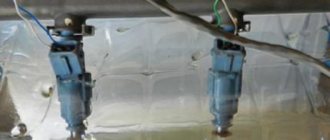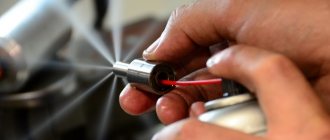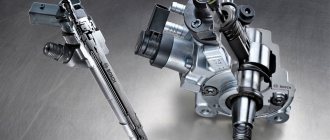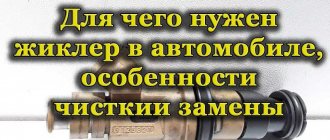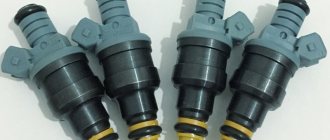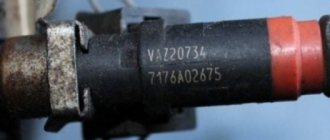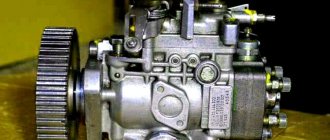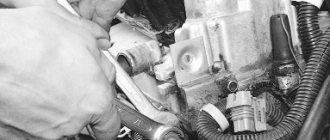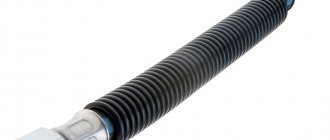Signs of a faulty diesel engine injector
Most often, a malfunction of diesel injectors is detected very quickly by the driver. But if the owner of a diesel car has no experience of owning such a car, then he may not immediately recognize the breakdown. The first thing you should pay attention to is the operation of the engine. At the first stages, no signs of breakdown appear. On the contrary, the car starts to drive a little better than usual. Yes, I didn’t make a mistake now. Everything is exactly like that. The fact is that due to faulty injectors, more fuel than required may enter the combustion chamber. Because of the rich mixture, the car starts to drive better.
If you miss this moment, then a smooth ride will gradually develop into a larger breakdown. After some time, you will begin to notice that the car began to smoke when starting, and the idle speed became unstable, and the speed began to fluctuate.
At the most advanced stages, fuel consumption increases significantly, and the car begins to smoke even when driving or sharply pressing the gas pedal. Gradually, as the injector pours fuel, it will begin to flow through the rings into the oil. This may cause the engine oil level to increase and its properties to deteriorate. And this can already lead to serious repairs.
Why do injectors on a diesel engine fail?
The injectors on a diesel engine come out faster than on a gasoline engine. This is due to the fact that these motors have different operating principles. But in both cases, the culprit is low-quality fuel or untimely replacement of the fuel filter. If you service the car on time, the injectors should work for at least 150,000 km without replacement or repair. If you also use high-quality fuel, then the factory injectors should last 200-300 thousand km.
But, as a rule, the fuel used is not of the highest quality, and filters are rarely changed. Therefore, the injectors in modern diesel engines hardly last 150 thousand km. Then they become dirty and begin to dose fuel incorrectly. To fix this, you will have to at least mechanically clean them of deposits and dirt. It is better not to put this procedure on the back burner, but to entrust the work to people who understand this.
Therefore, fill in high-quality fuel and do maintenance on time. High-quality, timely car maintenance will help you avoid unpleasant breakdowns in the future.
Operating principle of a diesel engine injector
Let us describe the design of the part using the example of a primitive mechanical injector with 1 spring. In the side part there is a channel that provides a continuous supply of diesel fuel. Inside the nozzle chamber there is a movable barrier with a spring and a needle, which lowers as pressure increases. The needle rises, clearing the path of fuel to the atomizer.
Additionally, more advanced types of nozzles can be noted:
- Piezoelectric: the spring pusher is lowered under the influence of a piezoelectric element. This technology ensures high intensity of opening of the nozzle: fuel savings are achieved, while the internal combustion engine operates more smoothly.
- Electrohydraulic: the design includes inlet and drain throttles, as well as an electromechanical valve. The operating mode of the components is regulated by the engine control unit.
- Pump injectors: used in engines that do not have a high pressure fuel pump. Fuel is supplied directly to the injectors. Inside such spray devices there is its own plunger pair, which generates the pressure necessary for injection.
Due to excessive loads, the injector may fail due to a violation of the engine operating mode. Manufacturers claim a parts life of up to 200,000 km, but due to negative operational factors, wear of parts appears much earlier.
Device
In essence, a modern injector is a valve based on a program-controlled electromagnet. It includes the following structural elements:
- rubber gasket;
- filter;
- connector;
- moving core induction coil controlled by ECU;
- core return spring;
- input manifold;
- spray needle;
- nozzle.
The injectors are located on the cylinder block head. How many there are depends on the total number of cylinders, since each requires one. The vast majority of passenger cars have 4 of them.
As for the layout, in most passenger cars the injectors are lined up in one row and mounted on a hollow metal tube through which fuel flows into them.
The easiest way to find out whether there are injectors in a particular engine and where they are located is to read the technical data sheet of the vehicle.
Before injectors began to be used on injection engines in conjunction with a control unit, they had a slightly different device. Instead of an induction coil with a movable core, they had a high-pressure valve, which was activated after the fuel was pumped by the fuel pump when a certain pressure was reached. Similar devices are still used on some models of diesel engines.
Causes of injector malfunction
Repair of diesel injectors may be required for the following reasons:
- Low quality diesel fuel: the scourge of all diesel drivers. Due to impurities in the fuel, the atomizer becomes clogged; the dosage and fuel supply mode are violated.
- Poor assembly quality of the injection component or manufacturing defect: the injector does not withstand operating conditions, the part as a whole or individual components fails.
- Mechanical damage caused by incorrect operation of adjacent internal combustion engine systems.
Usually the breakdowns are of the following nature: the spray angle and the amount of fuel supplied changes, the integrity of the housing is compromised, and the needle stroke worsens.
Checking the functionality of the injector
There are several methods for checking the functionality of the sprayer. The easiest way to check the injector is with the engine running:
- Start the engine at idle speed.
- Start unscrewing the nozzles one by one.
- If after removal the engine performance deteriorates, then the removed injector is operational and should be returned to its place.
- By process of elimination you will find an injector, the removal of which will not change the operating mode of the internal combustion engine. This will be a broken device.
You can use a multimeter for diagnostics. In advance, you need to disconnect the battery terminals and disconnect the injector wiring, and then “check” each part with the device. On high resistance injectors, the device values will be in the range of 11 - 17 ohms; at low impedance the multimeter will show up to 5 ohms.
Tip: Having a maximeter will be a big advantage. The device is able to show the current pressure at which the sprayer is activated. It will also help identify defects regarding the spray angle and injection jet configuration.
Cleaning methods
Currently, there are two main cleaning methods:
It should be noted that this method will not get rid of dirty injectors 100%. After this, flushing fluid remains in the oil system and injector. Therefore, experts recommend driving 10-15 km in forced engine operation, and then changing the oil filter and changing the oil. This method requires a significant investment of time and will cost a lot.
However, both methods are most suitable when the car’s mileage is low, and dismantling the injectors is quite difficult due to their location.
Troubleshooting
A faulty injector must be inspected. First, we look for leaks in the part body. If there are none, we proceed to disassembling the part. We fasten the part in a vice and knock out the spray nozzle by gently tapping it. Next, you need thorough cleaning: soak the parts of the nozzle in diesel fuel or solvent to remove carbon deposits. We remove soot and deposits with a fine steel grater. After cleaning is completed, you need to check the nozzle on the maximeter. If optimal injection parameters are achieved, the device is ready for installation in the engine.
In other cases, it is necessary to completely replace the nozzle on the defective nozzle. When installing a new part, carefully remove all factory grease, otherwise the device will not work.
If the nozzle continues to “flow” even after replacing the nozzle and thorough cleaning, pay attention to the performance of the spring with the pin - they may be worn out.
To clean the sprayer, use a compressor - the air pressure will knock out hard-to-reach dirt.
Location
View gallery
Many people do not know about injectors in a car. Where are these elements located? Their location depends on the type of injection:
- With central fuel injection, one or a pair of injectors are located inside the intake manifold, near the throttle valve. So, the nozzle is a replacement for an already outdated device - a carburetor.
- With distributed fuel injection, each cylinder has its own injectors installed in the car. Where are they in this case? At the base of the intake pipeline, into which fuel is injected by the nozzle.
- With direct fuel injection, they are located in the upper region of the cylinder walls. They inject fuel into the combustion chamber itself.
This is the location of the injectors in a car. Where these parts are located became clear.
Nozzle installation
Before dismantling the device, mark all parts with a marker to avoid confusion. Be especially careful about marking high-pressure hoses. The nozzle is screwed in by hand as far as you can. Further tightening is performed with a dynamometer wrench. The tightening values are indicated in the motor manual. When installing the injector, bleed the air from the fuel system. On modern cars, this is enough to turn the starter several times; or use a manual pump (if available).
Cases when the nozzle needs to be completely replaced
Let's list the main features:
- the resource declared by the manufacturer has been exhausted;
- there are breakdowns or other leaks in the housing;
- burnt nozzle nut: if the problem is not corrected at an early stage, the nozzle itself will become unusable.
Please note that on some engines, after installing a new injector, it is necessary to “bind” it to the engine: make changes to the settings of the control unit.
It is better to install the nozzle at a service station, since the station has bench equipment for adjusting and assessing the current condition of the part.
Design
The injector is the most important element in the injection system of gasoline engines. This is a solenoid valve that operates “under the command” of the ECU, the electronic engine control unit. After receiving pulses of a certain frequency, the ECU “measures” the dose of the required fuel, depending on the engine load and coolant temperature. The precise and well-functioning operation of this mechanism allows the engine to operate properly for a long time: lower fuel consumption, greater power and torque, easy engine starting at any temperature - all these are advantages of the well-functioning operation of the injector, but any malfunctions in its operation worsen the performance of the entire engine. Very often, the faulty operation of a gasoline engine is caused by electromagnetic injectors that do not perform their functions or are partially faulty. This is due to the fact that there is no electrical impulse to open the valve, perhaps the solenoid winding has broken, or the internal valves may be dirty. Dirty internal valves most often make themselves felt to the car owner in winter when starting an injection engine.
avtoexperts.ru
The fuel injector (FF), or injector, refers to the parts of the fuel injection system. It controls the dosing and supply of fuel and lubricants with its subsequent spraying in the combustion chamber and combining with air into a single mixture.
TFs act as the main executive parts related to the injection system. Thanks to them, the fuel is divided into small particles by splashing and enters the engine. Injectors for any type of engine serve the same purpose, but differ in design and operating principle.
This type of product is distinguished by individual production for a specific type of power unit. In other words, there is no universal model of this device, so it is impossible to switch them from a gasoline engine to a diesel one. As an exception, we can cite the example of hydromechanical models from BOSCH, installed on mechanical systems operating on continuous injection. They are widely used for various power units as an integral element of the K-Jetronic system, although they have several modifications that are not related to each other.
Location and principle of operation
Schematically, an injector is a software-controlled solenoid valve. It ensures that fuel is supplied to the cylinders in prescribed doses, and the installed injection system determines the type of products used.
Fuel is supplied to the injector under pressure. In this case, the engine control unit sends electric pulses to the injector electromagnet, which activate the needle valve, which is responsible for the state of the channel (open/closed). The amount of incoming fuel is determined by the duration of the incoming pulse, which affects the length of time the needle valve remains open.
The location of the injectors depends on the specific type of injection system:
• Central – located in front of the throttle valve in the intake manifold.
• Distributed – all cylinders are assigned a separate injector, located at the base of the intake manifold and injecting fuel and lubricants.
• Direct – the injectors are located at the top of the cylinder walls, which provides direct injection into the combustion chamber.
Injectors for gasoline engines
How to find the cause of the breakdown?
This is done using a special tester; first, they check the voltage supplied to the injectors (normal pressure is from 0 to 2-3V); if there is voltage, then everything is in order with the injector. Next, the injector valve windings are checked. During normal operation of the injectors, they have a resistance of 12-16 Ohms, in systems with turbocharging - 4-5 Ohms, and in systems with a monoinjector - 4-5 Ohms. The mobility of the injector solenoid valve is determined by instantly connecting the injector terminals to a power source, for example, to an engine battery. A normally operating injector will click slightly, this will indicate normal operation of the valve, and if the valve works but the cylinder does not, it means the injector is very dirty. At service stations, the level of contamination of injectors is checked using multitesters based on the duration of the pulses that the ECU sends to open the valve. If the nozzle is dirty, the pulse time increases. Also, if irregularities are detected in the engine’s operation, the toxicity of the exhaust gases can be checked. Their toxicity increases when the mixture is over-enriched, mixture formation deteriorates, and the combustible mixture cannot be ignited. If a three-component catalyst is installed in the car, then an increase in the content of nitrogen oxides can be an indicator of deterioration in the operation of the injectors. Moreover, if the foreign car is new, then unused fuel in the form of gases can quickly damage the catalyst.
Ultrasonic cleaning
A modern way to clean an injector is to use ultrasound. Here you will need to remove the injectors from the engine and place them in an ultrasonic bath. Cleaning is carried out using micro-explosions of ultrasonic waves capable of reaching thousands of atmospheres (cavitation effect). At the bottom of the bath there is an ultrasonic generator. The nozzles are lowered into it and, due to cavitation, the maximum effect of peeling off blockages in the nozzle channels and sediments in the nozzle channels is achieved.
Thanks to the use of an ultrasonic bath, the surface of the nozzle and its internal working cavities are cleaned . possible on the inner surface , since it is located in a working area of high pressure and high temperatures. The internal surface of the device is cleaned exclusively in the active cleaning mode. This mode assumes that the nozzles open and close while being in the working solution with the part that directly sprays the fuel - the spray hole, during ultrasonic cleaning.
Ultrasonic cleaning is considered more effective, since it can also be used to clean those nozzles that cannot be cleaned with flushing liquid. Flushing the injector using this method will cost a little more.
Ultrasonic cleaning steps:
Bench testing is an advantage of this method. It is recommended to use an ultrasonic bath after 100 thousand km or more often if engine diagnostics have shown the need for this . The main disadvantage of the method is its high cost and the need to resort to the help of specialists. Injectors may be damaged due to improper ultrasonic cleaning. Of course, first make sure that the interruptions in engine operation are due to dirty injectors.
Causes of clogged injectors
Poor quality fuel is one of the main reasons for injector failure. A huge amount of resins that settle inside the injectors reduce the throughput, they do not allow the valves to close hermetically, and thereby the angle of the injected fuel jet changes. When starting the engine in winter, a failed valve causes the mixture to become over-rich, resulting in increased fuel consumption and increased toxicity of exhaust gases. If fuel is sprayed incorrectly, disturbances occur in the mixture formation process, and this is the first reason for the deterioration of almost all engine performance. Clogging of injectors occurs when using fake fuel filters, or if the car owner simply forgot to change the filter. With pressure in the fuel system, the filter may simply rupture, and dirt will naturally enter the injectors.
First of all - diagnosis
Sergey Kamenev , Jetronic auto repair shop specialist:
— Try to avoid refueling at questionable gas stations. Using high-quality gasoline will extend the life of the injector. Follow the recommended fuel filter replacement intervals. When carrying out repair work, do not allow the fuel system to become clogged. It often happens that motorists see the procedure for cleaning injectors as a panacea for uneven engine operation. This is not true at all. Before carrying out this procedure, you need to make sure that your car really needs it. It is quite easy to determine this by first diagnosing the car. As a rule, the problem that appears is not the one that the car owner is at fault for.
Injector flushing
Separately, I would like to note that in foreign cars with high mileage, cleaning with additives can completely disable the entire system, when all the dirt from the unwashed system is washed off the walls of the fuel tank, and rushes to the filter, and then into the injectors. The mesh on the injectors becomes clogged and fuel stops flowing. Another method is to flush the injector without dismantling it, i.e. the injector remains undisassembled. First, turn off the gas tank, then the standard fuel pump, and close the fuel drainage channel into the tank. At the same time, the fuel line of the machine is connected to a professional stand, which supplies a special liquid to the system. Two fluid runs with two breaks - 15-20 minutes for every 15-20 thousand kilometers, and your fuel system will be prepared for winter. An ultrasonic stand is another cleaning method. The nozzles are removed and placed in a bath of cleaning solution, where even the strongest deposits are destroyed under the influence of ultrasound. At the same stand you can check the quality of cleaning. Experience has shown that the ultrasonic method is the most effective, and it can even bring back to life injectors that are no longer repairable.
Sources: drive2.ru, motorsguide.ru, oils-market.ru.
Cleaning the fuel system - getting ready for winter
As a rule, experienced motorists begin to prepare their iron horse for winter in advance. Everyone has their own plan of preparatory measures; it all depends on the general condition of the car and the result that the car owner is aiming for. Some inspect the suspension and purchase new winter tires, while others prioritize the condition of the engine, preparing it for operation in sub-zero temperatures. In the second case, one of the most important procedures is cleaning the fuel system, since it will determine how stable and confident the car will operate and start in the winter.
